Factor Olympics 1H 2019
And the Winner is…
July 2019. Reading Time: 10 Minutes. Author: Nicolas Rabener.
SUMMARY
- Most factors generated positive returns in 1H 2019
- Low Volatility produced the best and Value the worst performance
- Factor performance is comparable in the US & Europe, but markedly different in Japan
INTRODUCTION
We present the performance of five well-known factors on an annual basis for the last 10 years. We only present factors where academic research highlights positive excess returns across market cycles and asset classes. Other strategies like Growth might be widely-followed investment styles, but lack academic support and are therefore excluded.
METHODOLOGY
The factors are created by constructing long-short beta-neutral portfolios of the top and bottom 10% of stocks in the US, Europe and Japan, and 20% in smaller markets. Only stocks with a minimum market capitalisation of $1 billion are included. Portfolios rebalance monthly and transactions incur 10 basis points of costs.
FACTOR OLYMPICS: GLOBAL
The table below shows the long-short factor performance for the last 10 years ranked top to bottom. The global series is comprised of all developed markets in Asia, Europe, and the US. Aside from displaying the factor performance, the analysis highlights the significant factor rotation in terms of profitability from one year to the next.
The first half of 2019 was positive for most common equity factors, with only Value being meaningfully negative. The performance leadership is similar to the last decade with the triumvirate of Low Volatility, Quality, and Momentum factors exhibiting the highest returns. Value continues to generate negative returns and the performance accumulates to what can be considered a lost decade for investors focused on buying cheap stocks.
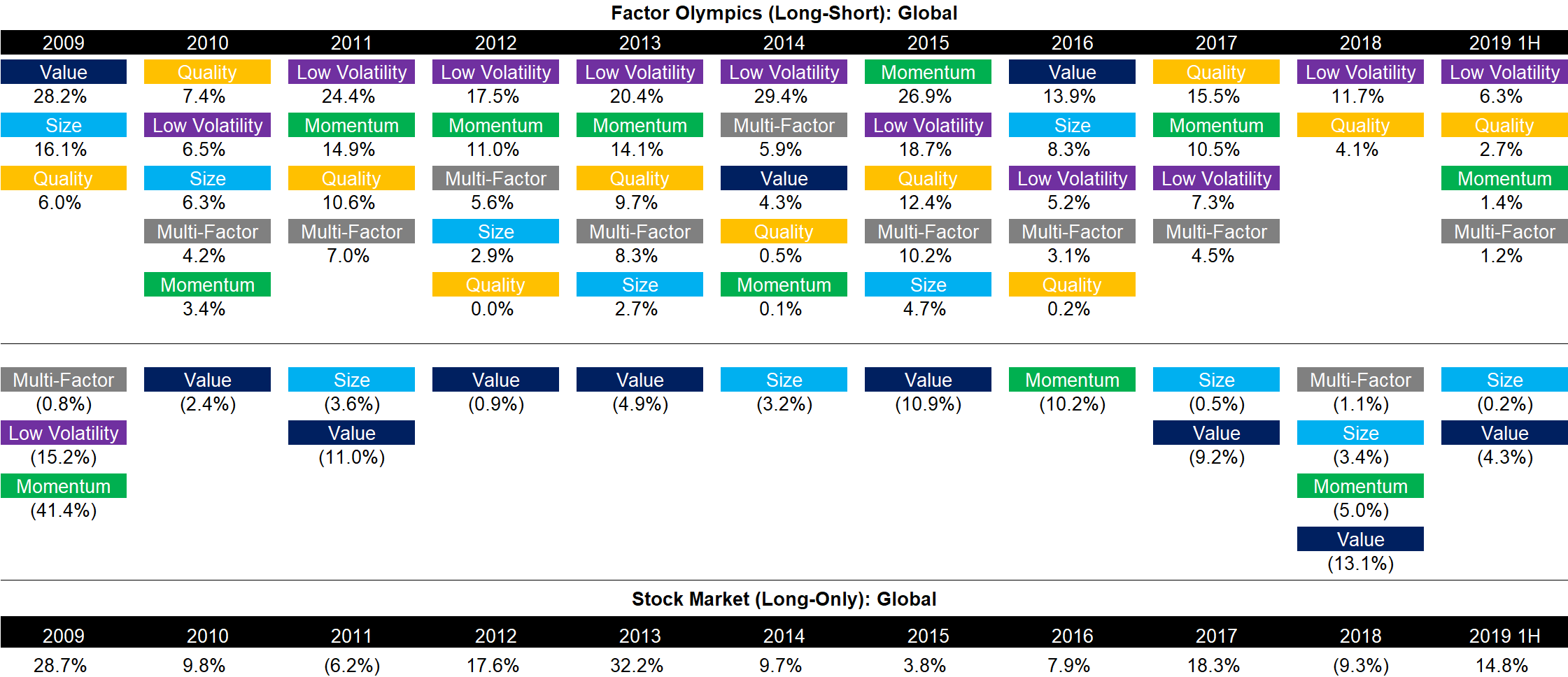
Source: FactorResearch
FACTOR PERFORMANCE 1H 2019: GLOBAL
Equity markets generated exceptionally strong positive returns globally in the first half of 2019. US and European stock markets produced double-digit returns. Market participants continue to be concerned that equity markets have decoupled from bond markets, which is especially stark in the US with the US 10-year treasury bond reaching 2.0% while the S&P 500 was making record highs. Historically yield compression and especially inverted yield curves have heralded recessions.
Some thoughts on the performance of the global long-short factors:
- Value & Low Volatility: There is no structural relationship between these two factors from a historical perspective, but in the first half of 2019 these behaved liked polar opposites, which was especially apparent from May onward, where Low Volatility generated strongly positive and Value significantly negative returns.
- Size, Momentum & Quality: These factors exhibited little volatility and are flat to slightly positive year-to-date.
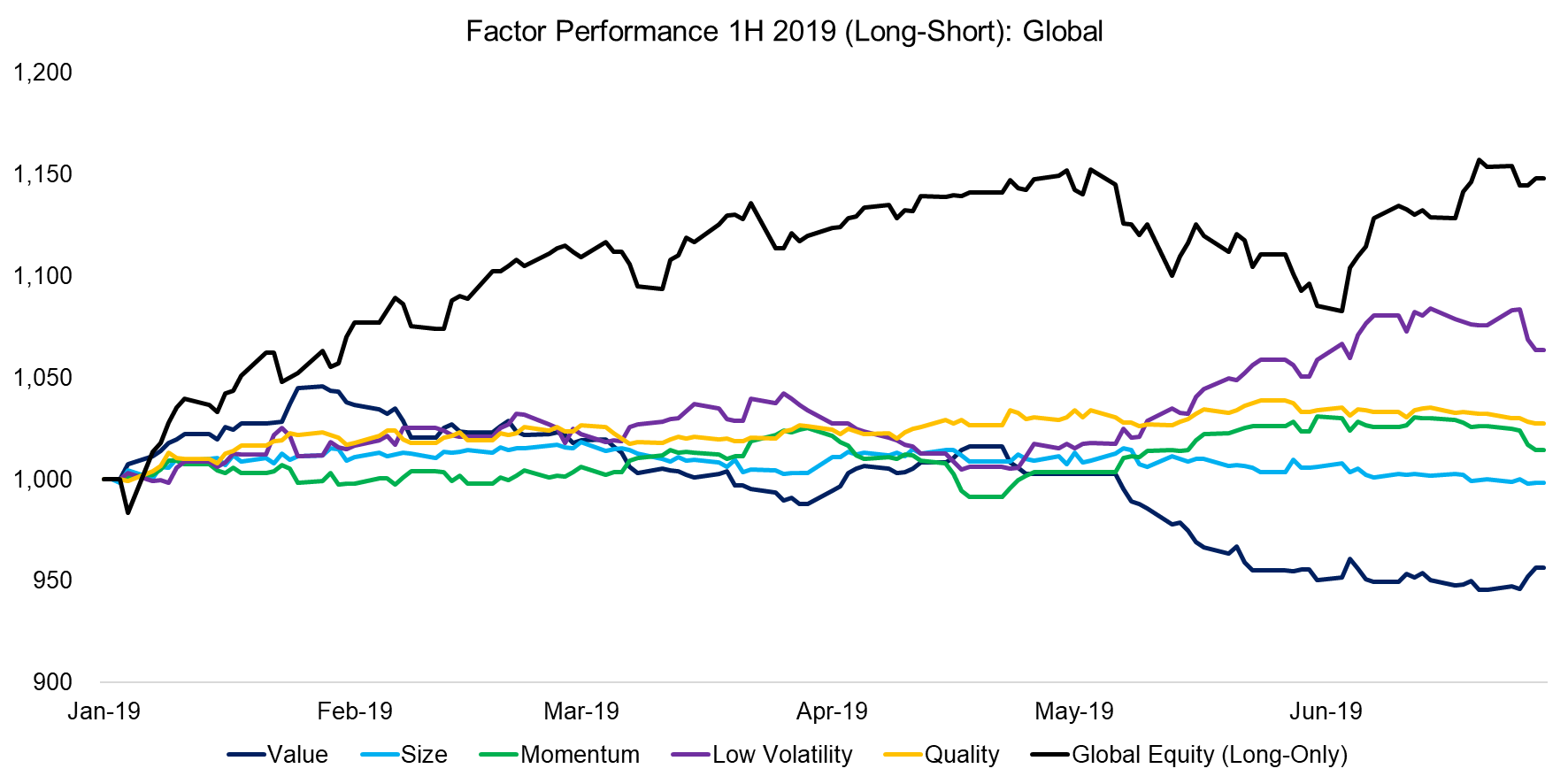
Source: FactorResearch
FACTOR PERFORMANCE 1H 2019: US
The global performance is significantly weighted towards the US, so it is not surprising that factor performance in the US is alike to the global returns. The performance in the second quarter of 2019 is essentially a continuation of the first quarter, highlighting factor momentum.
The factor performance in the US is led by the Low Volatility factor, which can be partially explained by the interest rate sensitivity of the factor and the continuous decrease in bond yields that started in November 2018. The portfolio of the factor has overweights in stocks from sectors like real estate and utilities that are not particularly volatile and can be considered bond-proxies based on the nature of their business models. Tech stocks have also performed strongly in the first half of 2019, which is reflected in the performance of the Momentum and Quality factors.
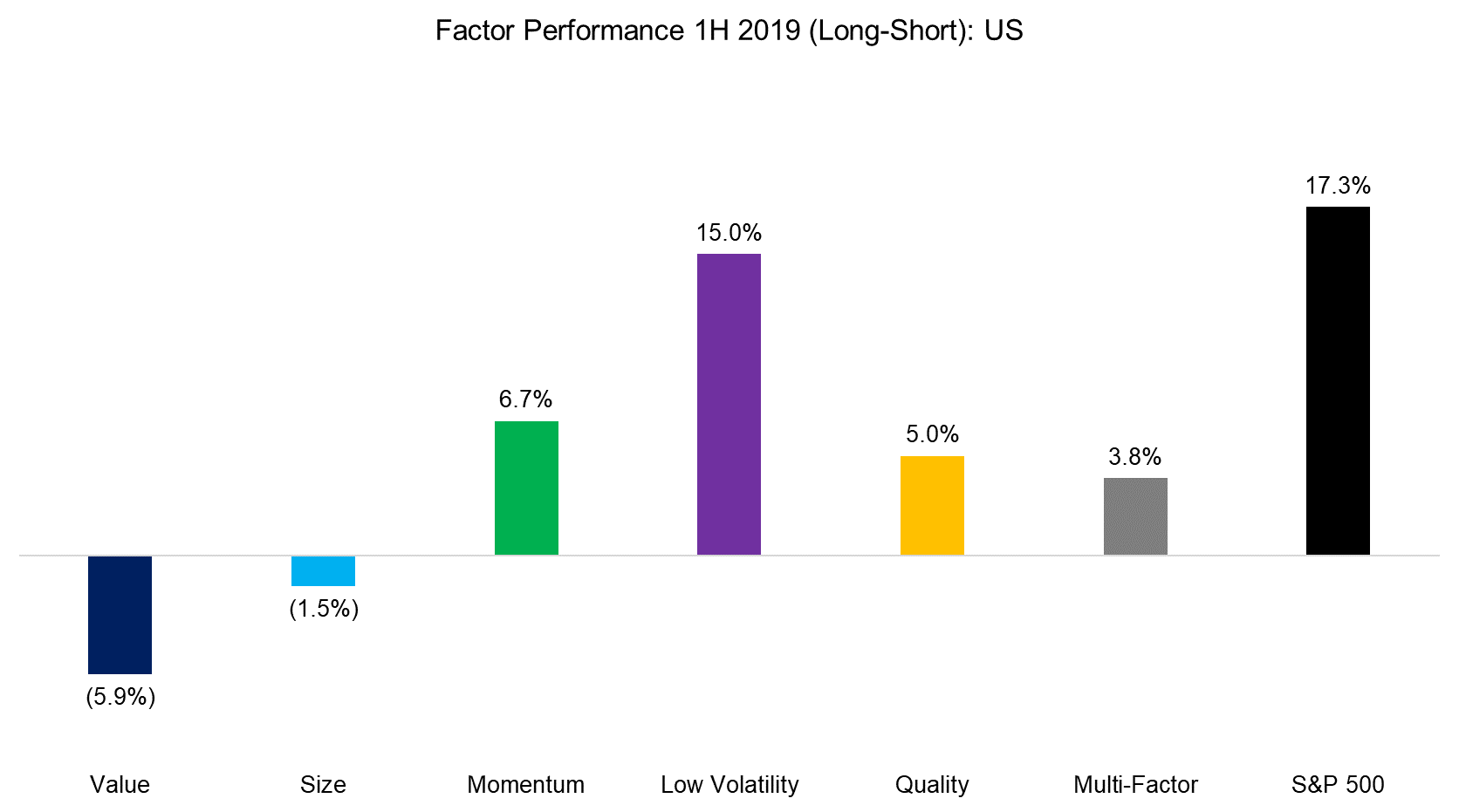
Source: FactorResearch
FACTOR PERFORMANCE 1H 2019: EUROPE
The factor performance in Europe is similar to the US in the direction of returns. However, while a multi-factor portfolio generated positive returns in the US, it was negative in Europe, which is mainly explained by the exceptionally poor performance of the Value factor. Although Momentum and Low Volatility were positive, they did not contribute enough.
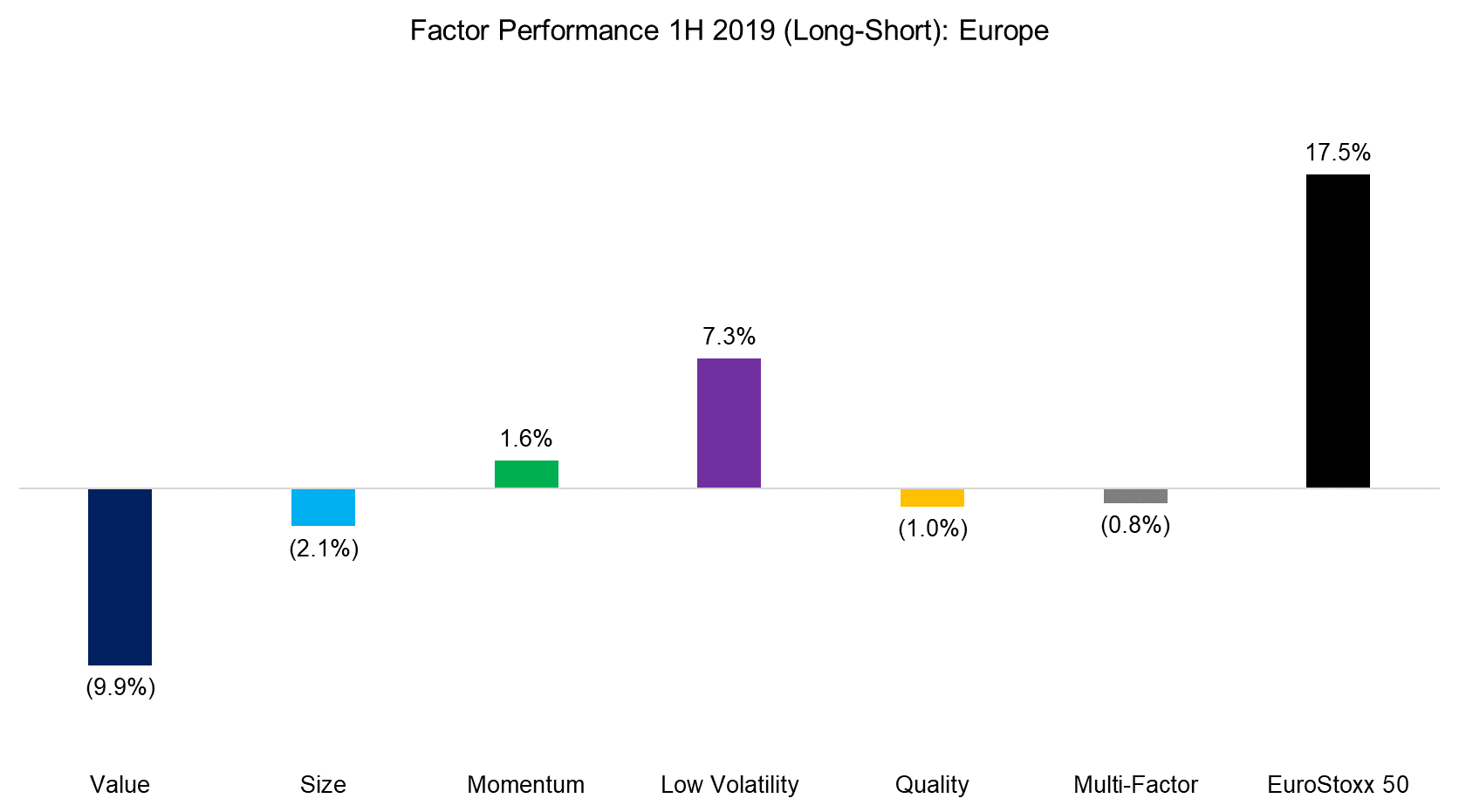
Source: FactorResearch
FACTOR PERFORMANCE 1H 2019: JAPAN
The long-term returns of common equity factors in the Japanese stock market have been lower than globally, but the trends in performance were typically the same, e.g. Value in Japan mirrors Value globally. However, in the first half of 2019, the factor performance has been markedly different to that in US and European stock markets (read Equity Factors In Japan).
None of the common equity factors was positive, which resulted in negative returns for a multi-factor portfolio. The difference to global markets is especially apparent for Low Volatility, which generated the strongest returns in the US and Europe, but the weakest in Japan. Perhaps the performance reflects that Japanese bond yields have reached zero decades ago and provide less tailwind for low-risk stocks than in other markets.
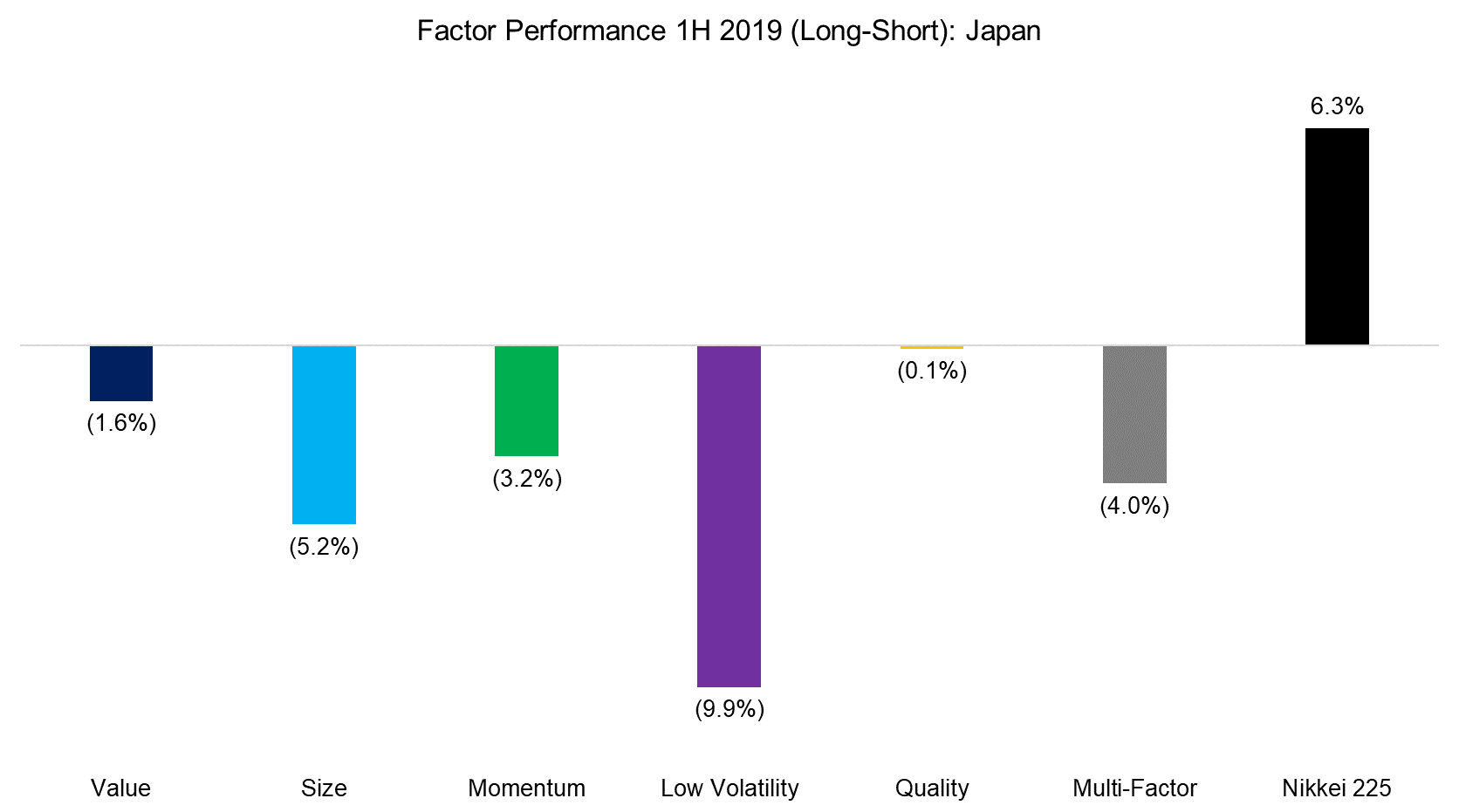
Source: FactorResearch
FACTOR CORRELATIONS
The correlation matrix below highlights the global one-year factor correlations. We observe a strong positive relationship between the Momentum and Quality factors, which is not structural in nature. The portfolios of both factors have overweights in the technology sector as these stocks have been performing strongly, are highly profitable and lowly levered. Investors concerned about their exposure to these two factors can consider the Value factor, which features negative correlations to both and therefore may provide diversification benefits (read Factors: Correlation Check).

Source: FactorResearch
FURTHER THOUGHTS
FTSE Russell’s 2019 smart beta survey was released on June 10th and highlights that the adoption of smart beta solutions of institutional investors increased to 58%, compared to 32% in 2014. It also reflects a strong preference for multi-factor over single-factor products, which is intuitive given the cyclicality of factor performance.
However, most multi-factor products offer strategic exposure to factors by weighting allocations equally or by factor volatility, which is not particularly efficient for harvesting factor returns. Factors have decade-long drawdowns and identifying their performance drivers allows to increase and decrease allocations when they are less or more risky. More innovative products are needed that allocate tactically to factors based on risk management frameworks reflecting the unique characteristics of factors.
RELATED RESEARCH
ABOUT THE AUTHOR
Nicolas Rabener is the CEO & Founder of Finominal, which empowers professional investors with data, technology, and research insights to improve their investment outcomes. Previously he created Jackdaw Capital, an award-winning quantitative hedge fund. Before that Nicolas worked at GIC and Citigroup in London and New York. Nicolas holds a Master of Finance from HHL Leipzig Graduate School of Management, is a CAIA charter holder, and enjoys endurance sports (Ironman & 100km Ultramarathon).
Connect with me on LinkedIn or X.

